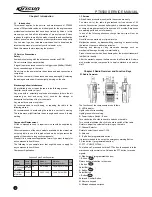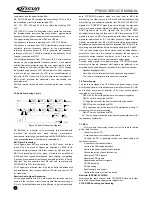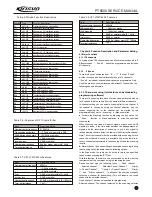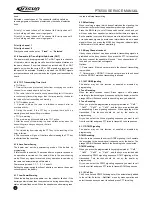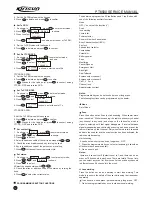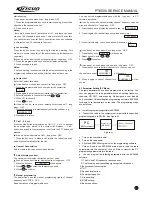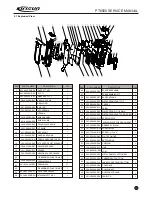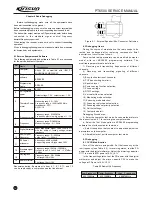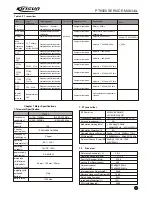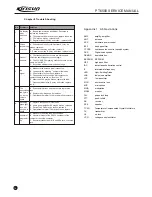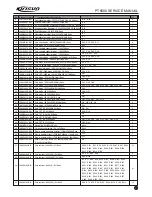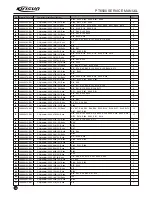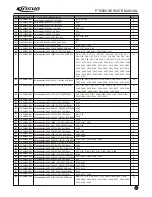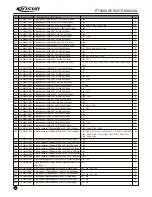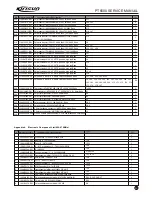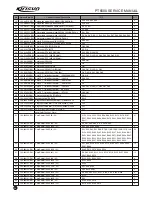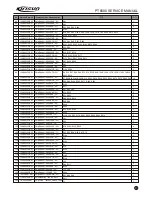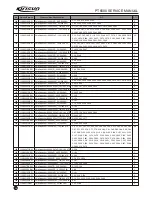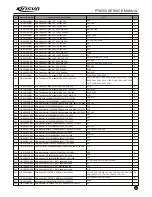
Chapter 6 Radio Debugging
Before test/debugging, make sure all the equipments have
been well connected to the ground!
Before test/debugging, make sure the antenna output terminal has
been connected properly to the corresponding devices and load!
The transmitter output must pass RF power attenuator before being
c o n n e c t e d t o t h e s t a n d a r d s i g n a l s o u r c e / f r e q u e n c y
deviator/frequency spectrum!
When testing the receiver, make sure not to conduct transmitting
operation!
When in debugging/testing/service, make sure static free measures
for human body and equipments.
6.1 Service Equipment and Software
The following equipments and software in Table 6.1 are necessary
for the service and test of the radio.
NO
1
2
3
4
5
6
7
8
9
10
11
12
13
14
Name
Computer
Programming
software
Programming
Cable
Cloning cable
DC regulated
power
Therefore Power
meter
Frequency meter
Frequency
Deviator
Digital Multimeter
Audio Signal
Generator
RF Power
attenuator
Standard signal
source
Oscillograph
Audio voltmeter
KSP6500
KSPL-09
KCL01
5A
SWR
1.2
-6
1
10
0--
5kHz
Specifications
Above P2, compatible with IBM PC,
WINDOWS 98/ME/2000/XP
Output voltage: 7.5V, output current:
Measuring rang: 0.5---10W
Frequency range: 100MHz500MHz
Impedance: 50Ù
Frequency range: 0.1600MHz
Frequency precision: higher than
Sensitivity: higher than 100mV
Frequency range: DC600MHz
Measuring range:
Input impedance: higher than 10MÙ/V DC,
w
ith the ability of testing voltage, current,
impedance
Frequency range: 2---3000Hz
output level: 1---500mV
Attenuation: 40dB or 50dB
Supporting power: Bigger than 10W
Frequency range: 10MHz---1000MHz
Output level: 0.1uV~32mV (-127dBm~-
17dBm)
Frequency range: DC~20MHz
Test range: 10mV~20V
Test range: 10mV~10V
6.2 Debugging Items
During the course of maintenance, the radio needs to be
tested and debugged after replacing components. Brief
description of circuits is as follows.
Some certain radio parameters can be modified (computer
mode) with our KSP6500 programming software. The
modifiable parameters are as follows:
1) Receiving and transmitting frequencies of different
channels;
2) Receiving and transmitting signaling of different
channels;
3) Busy-lock selection of channels;
4) TOT transmitting time limit;
5) Squelch level;
6) Power-saving function selection;
7) 2-tone settings;
8) DTMF settings;
9) Voice alert function selection;
10) Monitoring mode selection;
11) Scanning mode selection;
12) Scanning reply channel selection;
13) Scanning channel priority selection;
14) Call list settings;
15) Customized alert;
Debugging Procedures:
A, Enter the computer test mode. Access method refers to
the instruction in 4.2.1 for entering the computer mode.
b, Select the Test Mode option in KPS6500 programming
software to enter the computer test mode.
c, Select the options that you want to adjust and adjust the
parameters on the computer.
d, After adjustment, exit the computer test mode.
6.3
Debugging
6.3.1 VCO Modification
Turn off the power saving mode. Set the frequency at the
low frequency (see Table 6.2). In receiving status, test the PD
power with the digital multimeter. Adjust the trimming capacitor
C117 to make the PD power at 4.2V
0.1V
In the transmitting status, test the PD power with the digital
multimeter and adjust the micro capacity C52 to make the
voltage at PD point at 4.2V 0.1V
PT6500 SERVICE MANUAL
Recommendation: Equipment in item 6, 7, 8, 10, 11, and 12
can be replaced by a comprehensive test instrument.
Figure 6.1 External Speaker/Mic. Connector Definition
MIC JACK
MIC RXD
SPEAKER JACK
SP+
SP-
TXD
GND
400.125MHz
435.125MHz
469.975MHz
Table 6.2 Radio H/I/L Frequency
Low
Frequency
Center
frequency
Hi gh Fr eq ue nc y
14
Summary of Contents for PT6500
Page 1: ...PROFESSIONAL TWO WAY RADIO PT6500 V071208 FM PORTABLE RADIO SERVICE MANOAL Welcome ...
Page 33: ...PT6500 SERVICE MANUAL Figure 1 PT6500 Top Main Board Position Number Diagram 136 174MHz 32 ...
Page 34: ...PT6500 SERVICE MANUAL Figure2 PT6500 Bottom Main Board Position Number Diagram 136 174MHz 33 ...
Page 35: ...Figure 3 400 470MHz PT6500 Top Main Board Position Number Diagram 34 PT6500 SERVICE MANUAL ...
Page 36: ...35 PT6500 SERVICE MANUAL Figure 4 400 470MHz PT6500 Bottom Main Board Position Number Diagram ...
Page 37: ...Figure 5 PT6500 PTT Top Board Position Number Diagram 36 PT6500 SERVICE MANUAL ...
Page 38: ...37 PT6500 SERVICE MANUAL Figure 6 PT6500 PTT BOTTOM Board Position Number Diagram ...



